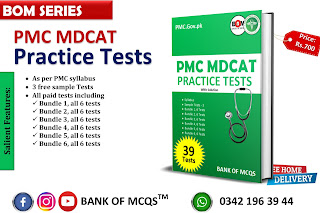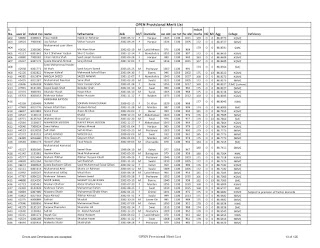chapter atomic structure MCQs
CHAPTER 4
ATOMIC STRUCTURE
Q.1. Color of the glow produced in the
discharge tube
a. depends on the pressure in the
discharge tube
b. depends on the metal used as
cathode
c. depends on the gas used in the
discharge tube
d. does not depend on the nature of
the gas used in the discharge tube
(c)
Q. 2. Dr. Khan told his students that
if charge on electrons in a chamber is 3.50 x 10 11 coulomb than mass of
electrons must be
a. 9.1 x 10-31 kg
b. 8 kg
c. 4 kg
d. 2 kg
(d)
Q. 3. e/m ratio of the canal rays is
less than that of cathode rays. The reason is
a. greater mass of canal ray particles
b. greater charge of the canal ray
particles
c. greater mass and charge of the
canal ray particles
d. actually e/m ratio of canal rays is
greater than that of the cathode rays
(a)
Q. 4. Nuclear radiation is emitted by
those elements whose
a. molecules are stable
b. molecules are unstable
c. nuclei are stable
d. nuclei are unstable
(d)
Q. 5. -rays are good ionizers of gases
because they
a. have greater mass
b. have positive charge
c. have greater mass and positive
charge
d. are helium nuclei
(c)
Q. 6. Consider the following reaction Be
+ He C + n
This reaction is
a. a chemical reaction
b. a nuclear reaction
c. an example of artificial
radioactivity
d. an exothermic reaction
(c)
Q. 7. Roentgen discovered X-rays and
Mosley found that the frequency of the X-rays emitted from anode increases with
the
a. increase in the mass number of the
metal used as anode
b. decrease in the mass number of the
metal used as anode
c. decrease in the proton number of
the metal used as anode
d. increase in the proton number of
the metal used as anode
(d)
Q. 8. Radiation emitted by exited
atoms is
a. in the form of continuous waves
b. in the form of quanta
c. nuclear radiations
d. ultraviolet radiation
(b)
Q. 9. If the electron of hydrogen atom
jumps of “M” shell then the radius of this excited hydrogen
atom will be
a. 8.464 Ao
b. 4.761 Ao
c. 2.116 Ao
d. 0.529 Ao
(b)
Q. 10. If a particle of mass 0.1gram
moves with a velocity of 10,000 m/s then the wavelength of the wave associated
with this particle is
a. 6.626 x 10-34 m
b. 2.145 x 10-39 m
c. 3.313 x 10-21 m
d. 1.325 x 10-18 m
(a)
Q. 11. Second ionization energy
a. is always less than first
ionization energy
b. is always greater than first
ionization energy
c. is equal to the first ionization
energy
d. may be greater or less than the
first ionization energy depending on the nature of the
element
(b)
Q. 12. “Ionization energies of the
elements of the 5th group are greater than those of 6th group”. It is because
a. 5th group elements have less
electronegativity
b. 6th group of elements have greater
shielding effect
c. 5th group element have greater
shielding effect
d. 5th group elements have half filled
atomic orbitals
(d)
Q. 13. A sodium lamp emits yellow
light with a wavelength of 589 nm. What is the energy of a
single photon in this light?
a. 3.37 x 10-19 Joules
b. 1.12 x 10-25 Joules
c. 1.17 x 10-33 Joules
d. 5.09 x 1015 Joules
(a)
Q. 14. The energy associated with the
transition of an electron from the n=1 state to the n=3 state of H atoms is:
a. +1.74 x 10-17 Joules
b. +1.94 x 10-18 Joules
c. +1.94 x 10-18 Joules
d. -1.74 x 10-17 Joules
(b)
Q. 15. All of the following are
electromagnetic radiations except
a. red light
b. sound waves
c. x-rays
d. photon
(b)
Q. 16. This shape of a 2s orbital
resembles:
a. a hockey puck
b. an (American) football
c. an ellipse
d. a sphere
(d)
Q. 17. Which orbital of the following
has a principal quantum number of 3 and an angular
momentum quantum number of 27
a. 3s
b. 3d
c. 4f
d. 3f
(b)
Q. 18. Which of the following has the
highest energy?
a. gamma rays
b. X-rays
c. Ultra-violet radiation
d. radio waves
(a)
Q. 19. All of the following elements
are correct for atomic orbitals except
a. p-sub energy level has 3 orbitals
b. s-orbital has spherical shape
c. energy of 4s is less than that of
4d
d. All d orbitals have 4 lobes
(d)
Q. 20. Various values of the quantum
numbers (n, /, m, ms) are listed below. Which is a possible
set of values for one of the d
electrons in an iron atom in its ground state?
a. (1, 1, 0, ½)
b. (4, 0, 1, ½)
c. (4, 1, 0, -1/2)
d. (3, 2, 1, -1/2)
(d)
Q. 21. How many orbitals are allowed
for principal quantum number (n) of 3?
a. 9
b. 8
c. 6
d. 4
(a)
Q. 22. Which of the following orbitals
are degenerate in a multielectron atom?
a. 3d orbitals
b. 3s, 3p, 3d orbitals
c. 1s, 2s orbitals
d. 2d orbitals
(a)
Q. 23. The quantum number that
specifies the way the orbital is oriented in space is:
a. the electron spin quantum number
b. the magnetic quantum number
c. the angular momentum quantum number
d. the principal quantum number
(b)
Q. 24. Which of the following has the
largest wavelength?
a. visible light
b. x-rays
c. infrared light
d. ultraviolet radiation
(c)
Q. 25. Select the arrangement of
electromagnetic radiation which starts with the lowest energy
and increases to greatest energy.
a. radio, visible, infrared, visible,
ultraviolet
b. microwave, infrared, visible,
ultraviolet
c. visible, ultraviolet, infrared,
gamma rays
d. X-radiation, visible, infrared,
microwave
(b)
Q. 26. A radio station broadcasts
music at 99.1 MHz. The wavelength of these waves is
a. 1.88 x 10-2 m
b. 0.330 m
c. 3.03 m
d. 5.33 x 102 m
(c)
Q. 27. Green light has a wavelength of
5200A. Calculate the energy of one photon of green light.
a. 3.4 x 10-40 J
b. 3.4 x 10-30 J
c. 3.8 x 10-26 J
d. 3.8 x 10-19 J
(d)
Q. 28. The size of an atomic orbital
is associated with
a. principal quantum number (n)
b. angular momentum quantum number (I)
c. magnetic quantum number (mI)
d. spin quantum number (ms)
(a)
Q. 29. Which of the following is a
correct set of quantum numbers for an electron in a 5f orbital?
a. n = 5, I = 3, mI = +1
b. n = 5, I = 2, mI = +3
c. n = 4, I = 3, mI = 0
d. n = 4, I = 2, mI = +1
(a)
Q. 30. In the quantum mechanical
treatment of the hydrogen atom, which one of the following
combinations of quantum numbers is not
allowd?
a. 3, 1, -1
b. 3, 2, 2
c. 3, 2, -1
d. 3, 3, 2
(d)
Q. 31. “Each electron in an atom must
have its own unique set of quantum numbers” is a
statement of
a. Aufbau principle
b. Pauli exclusion principle
c. Hund’s rule
d. Periodic law
(b)
Q. 32. The effective nuclear charge
for an atom is less than the actual nuclear charge due to
a. Shielding
b. Penetration
c. Paramagnetism
d. Electron-pair repulsion
(a)
Q. 33. “Electrons added to atomic
orbitals of the same energy will remain unpaired with parallel
spins until the subshell is more than
half-filled” is a statement of
a. Aufbau principle
b. Pauli exclusion principle
c. Hund’s rule
d. Periodic law
(c)
Q. 34. All of the following statements
are correct for atomic structure and quantum numbers except
a. In a given atom, the maximum number
of electrons having principal quantum number n= 3, is 18
b. The number of orbitals in a given f
subshell is 7
c. For n=4, the largest
possible value of I is 3
d. For n=4, the largest
possible value of mI is 2
(d)
Q. 35. Select the correct electron
configuration for Cu (Z=29)
a. [Ar] 4s23d9
b. [Ar]4s13d10
c. [Ar]4s24p63d3
d. [Ar]4s14d9
(b)
Q. 36. Arrange potassium, rubidium,
calcium and barium in order of increasing atomic size.
a. K < Ca < Rb < Ba
b. Ca < K < Rb < Ba
c. Ca < K < Ba < Rb
d. K < Ca < Ba < Rb
(b)
Q. 37. Element having smallest atomic
radius among the following is
a. Li
b. Ne
c. Rb
d. Sr
(b)
Q. 38. The arrangement of sodium,
oxygen, fluorine and strontium on the basis of increasing first
ionization energy is
a. Na < Sr < O < F
b. Sr < Na < O < F
c. Sr < Na < F < O
d. Na < Sr < F < O
(b)
Q. 39. Elements with _____ first
ionization energies and _______ electron affinities generally form
cations.
a. low, very negative
b. high, positive or slightly negative
c. low, positive or slightly negative
d. high, very negative
(c)
Q. 40. In a Millikan oil-drop
experiment, the charges on several different oil drops were as follows:
-5.92; -4.44; -2.96; -8.88. The units
are arbitrary. What is the likely value of the electronic
charge in these arbitrary units?
a. -1.11
b. -1.48
c. -2.22
d. -2.96
(b)








Comments
Post a Comment